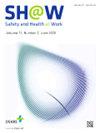学校厨师胸部计算机断层扫描结果的放射学变化:与年龄匹配对照的比较研究
IF 2.9
3区 医学
Q1 PUBLIC, ENVIRONMENTAL & OCCUPATIONAL HEALTH
引用次数: 0
摘要
本研究探讨长期接触烹调油烟的学校厨师呼吸系统的亚临床放射学变化。方法使用低剂量胸部计算机断层扫描数据,我们将88名学校厨师与年龄和性别匹配的对照组88人进行比较,以评估肺结节、支气管壁增厚和淋巴结大小变化的存在。结果炊事人员中固体结节的患病率(75.0% vs. 33.0%, p <;0.001)。暴露组右侧支气管壁厚度(1.41±0.19 mm比1.33±0.18 mm, p = 0.004)和左侧支气管壁厚度(1.31±0.21 mm比1.25±0.20 mm, p = 0.044)均显著增高。厨师在不同部位也有较大的淋巴结:右侧气管旁或肺门(4.12±1.66 mm vs. 3.13±1.36 mm, p <;0.001),左侧气管旁或肺门(2.63±1.50 mm vs. 1.98±1.27 mm, p = 0.002),隆突下(3.44±1.58 mm vs. 2.47±1.16 mm, p <;0.001),右下叶间叶(3.90±1.16 mm vs. 2.85±0.90 mm, p <;左下叶间叶(3.83±1.22 mm vs. 3.02±1.11 mm, p <;0.001)。结论:本研究表明,长期从事学校厨师工作的个体在肺部表现出亚临床但可检测的放射学表现。本文章由计算机程序翻译,如有差异,请以英文原文为准。
Radiological Changes in Chest Computed Tomography Findings of School Cooks: A Comparative Study With Age-matched Controls
Background
This study investigates subclinical radiologic changes in the respiratory system in school cooks with long-term exposure to cooking oil fumes.
Methods
Using low-dose chest computed tomography screening data, we compared 88 school cooks to an age- and sex-matched control group of 88 individuals to assess the presence of lung nodules, bronchial wall thickening, and lymph node size variations.
Results
The results demonstrated a significantly higher prevalence of solid nodules in cooks (75.0% vs. 33.0%, p < 0.001). Additionally, the thickness of the right bronchial wall (1.41 ± 0.19 mm vs. 1.33 ± 0.18 mm, p = 0.004) and the left bronchial wall (1.31 ± 0.21 mm vs. 1.25 ± 0.20 mm, p = 0.044) were significantly greater in the exposed group. Cooks also had larger lymph nodes at various sites: right paratracheal or hilar (4.12 ± 1.66 mm vs. 3.13 ± 1.36 mm, p < 0.001), left paratracheal or hilar (2.63 ± 1.50 mm vs. 1.98 ± 1.27 mm, p = 0.002), subcarinal (3.44 ± 1.58 mm vs. 2.47 ± 1.16 mm, p < 0.001), right inferior interlobar (3.90 ± 1.16 mm vs. 2.85 ± 0.90 mm, p < 0.001), and left inferior interlobar (3.83 ± 1.22 mm vs. 3.02 ± 1.11 mm, p < 0.001).
Conclusion
This study demonstrated that individuals with long-term employment as school cooks exhibited subclinical yet detectable radiologic findings in the lungs.
求助全文
通过发布文献求助,成功后即可免费获取论文全文。
去求助
来源期刊

Safety and Health at Work
Social Sciences-Safety Research
CiteScore
6.40
自引率
5.70%
发文量
1080
审稿时长
38 days
期刊介绍:
Safety and Health at Work (SH@W) is an international, peer-reviewed, interdisciplinary journal published quarterly in English beginning in 2010. The journal is aimed at providing grounds for the exchange of ideas and data developed through research experience in the broad field of occupational health and safety. Articles may deal with scientific research to improve workers'' health and safety by eliminating occupational accidents and diseases, pursuing a better working life, and creating a safe and comfortable working environment. The journal focuses primarily on original articles across the whole scope of occupational health and safety, but also welcomes up-to-date review papers and short communications and commentaries on urgent issues and case studies on unique epidemiological survey, methods of accident investigation, and analysis. High priority will be given to articles on occupational epidemiology, medicine, hygiene, toxicology, nursing and health services, work safety, ergonomics, work organization, engineering of safety (mechanical, electrical, chemical, and construction), safety management and policy, and studies related to economic evaluation and its social policy and organizational aspects. Its abbreviated title is Saf Health Work.
 求助内容:
求助内容: 应助结果提醒方式:
应助结果提醒方式:


